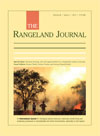
The Rangeland Journal
Volume 36 Number 4 2014
Special IssueSavanna Burning: Role and Opportunities in a Rangelands Carbon Economy
RJ13122Fire and carbon management in a diversified rangelands economy: research, policy and implementation challenges for northern Australia
Fire is a substantial source of greenhouse gas (GHG) emissions from the land sector throughout the world. A carbon economy potentially provides a new opportunity for land managers to diversify their livelihoods by adopting fire management practices that reduce GHG emissions and increase carbon sequestration. The papers in this Special Issue present technical, policy and stakeholder perspectives for achieving better conservation, emissions and economic outcomes from improved burning practices in northern Australia.
RJ14030How hot? How often? Getting the fire frequency and timing right for optimal management of woody cover and pasture composition in northern Australian grazed tropical savannas. Kidman Springs Fire Experiment 1993–2013
Can fire be used to manage the increasing woody cover in grazed savannas in northern Australia? This 20-year study found that 4-yearly late dry season fires provided the most effective management of woody cover and pasture composition, while more frequent or early fires caused an undesirable change in pasture composition. This is contrary to recommendations for early dry season fires for biodiversity conservation and greenhouse emissions reduction, and suggests optimal fire management will vary with land use and prevailing fire regimes.
RJ13123Aboveground and belowground carbon dynamics in response to fire regimes in the grazed rangelands of northern Australia: initial results from field studies and modelling
Australia’s rangelands may offer considerable potential as a carbon sink that could help manage atmospheric carbon levels, but few data are available to assess this potential or to inform the type of fire and grazing management that would be necessary. Simulation modelling suggested that reducing fire frequency in grazed northern Australian savannas increased carbon stocks mainly through a build-up of woody vegetation, although this trend was not apparent in a field study of experimental fire regimes. Further studies are required to better understand the carbon sequestration potential of the rangelands.
RJ14044Impacts of fire on soil organic carbon stocks in a grazed semi-arid tropical Australian savanna: accounting for landscape variability
Fire and grazing in Australian tropical savannas is commonplace, yet their management on soil organic carbon (SOC) stocks is not well understood. SOC stocks were measured at a long term fire experimental site in a grazed tropical savanna, accounting for background spatial variability and treatment replication (in the absence of baseline values). The lack of significant treatment differences illustrates the importance of accounting for these factors when developing accurate and cost-effective methodologies for land managers in the C economy.
RJ13129Fire patterns in north Australian savannas: extending the reach of incentives for savanna fire emissions abatement
We examine fire patterns and associated greenhouse gas emissions in north Australian savannas over a period of 15 years. We seek to identify the geographic area over which it may be plausible, under Australian carbon farming law, to extend options to earn carbon credits by reducing fire-generated emissions. We conclude that significant abatement may be achieved using approved methods in areas receiving above 600 mm rainfall annually but also showing extreme rainfall seasonality, evidenced by rainfall of less than 15 mm in the driest quarter.
RJ13128Carbon projects and Indigenous land in northern Australia
The world’s first national land carbon offsets scheme, Australia’s Carbon Farming Initiative, offers great potential for Indigenous landowners to boost income from the land. However, meeting land requirements means navigating a maze of state and federal legislation. This paper provides a snapshot of the pathways open for Indigenous landowners in northern Australia, and points out problems which might stand in the way of successful projects.
RJ14025Opportunities for fire and carbon on pastoral properties in the savanna rangelands: perspectives from the Indigenous Land Corporation and the Northern Territory Cattlemen's Association
This paper explores the potential for pastoral properties to diversify income through participation in carbon markets through early dry season savanna-burning projects. An examination of the experiences of the Indigenous Land Corporation and the pastoral industry in the Northern Territory of Australia exposes the benefits of carbon projects and the need to undertake further research into the practicalities of introducing carbon projects into predominantly pastoral landscapes.



